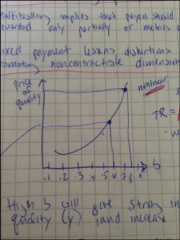![]()
![]()
![]()
Use LEFT and RIGHT arrow keys to navigate between flashcards;
Use UP and DOWN arrow keys to flip the card;
H to show hint;
A reads text to speech;
6 Cards in this Set
- Front
- Back
|
What is multi-tasking?
|
Challenge of designing incentives to motive appropriate effort across multiple tasks when desired outcomes for some tasks are more difficult to measure than others (Eggelston, 2004)
|
|
|
Why is a mixed payment system optimal?
|
- Helps create robust system less prone to distortions
- Helps balance incentives for quality effort across services; Advantage in balancing contractible and non-contractible quality. - Best when we cannot observe everything. (when we have x that is observable and y that is not observable) |
|
|
What is the model for paying hospitals?
|
TR = a +bx
TC = x + y TR = TC a + bx = x + y |
|
|
What are some distortions that might occur if the balance of fixed vs bonus (b) payments is not right?
|

- Since function of b in nonlinear, high b will cause large distortions and make producing quality much more costly compared to volume.
- More incentive to cut quality, rather than volume. A $100 million cut in volume will result in $100 million deficit, while a $100 million cut in quality will result in balance. - High b will give strong incentive to cut things not in payment system (ie quality) - Only incentivizing observable (ie volume) gives strong incentives to focus only on that. |
|
|
What are 4 implications of this model due to the non-linear function of b?
|
1) Worse to set b too high than too low; b grows very quickly to right of b*
2) With full info, will set b higher than with uncertainty. 3) WIth uncertainty, will be afraid to set b too high and set lower to guard against distortions 4) Large disagreement --> Large distortions (ie if govt care more about volume and doctors more about quality, the govt will have to incentivize physician behavior with higher b, thus causing distortions.) |
|
|
What are some conclusions about multi-tasking, payment system and associated distortions?
|
- Multi-tasking implies that payers should use p4p cautiously as long as quality is only partially rewarded or imperfect (ie as long as there are non-contractible unobservable qualities in the system)
- Mixed payment systems lessen distortions in effort allocation when p4p is imperfect, thus promoting non-contractible dimensions of quality that complement treatment. - Mixed payment systems helps p4p avoid perversely rewarding providers for skimping on non-contractible dimensions of quality. |

